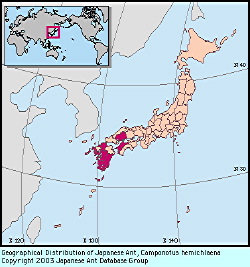
|
species
|
Camponotus hemichlaena
|
 |
Japanese Name
|
Nishi-muneaka-oo-ari
|
Original Reference
|
|
Yasumatsu, K. & Brown, W.L., Jr. (1951) Revisional notes on Camponotus herculeanus Linné and close relatives in the Palaearctic regions. Journal of the Faculty of Agriculture, Kyushu University 10: 29-44.
|
Synonym
|
|
Camponotus obscuripes hemichlaena Yasumatsu & Brown (Yasumatsu & Brown, 1951) ,
Camponotus hemichlaena Yasumatsu & Brown (Yasumatsu & Brown, 1957) ,
|
Description
|
|
Total length of workers around 7 - 12 mm. Body bicolored: mesosoma (excluding pronotum), petiole and basal portion of 1st gastral segment red; the remainder black. Hairs on posterior section of 2nd gastral tergite not extending beyond its posterior margin.
|
Remarks
|
|
This species is distinguished from C. obscuripes by its black pronotum (pronotum red in C. obscuripes). It was originally described as a subspecies of C. obscuripes and later raised to species rank by Yasumatsu & Brown (1957). However, since no other morphological distinctions have been observed between it and C. obscuripes, separation from obscuripes depends exclusively on coloration. Further study on its taxonomic status is needed. Both C. hemichlaena and C. obscuripes are present in Shikoku and Kyushu, with obscuripes tending to distribution at higher elevations. On Honshu, C. hemiclaena is known only from Hiroshima.
|
|

Distribution
|
|
Honshu (Chugoku District), Shikoku, Kyushu, Yaku I.
|
|
References
|
|
- Yasumatsu, K. & W. L. Brown, Jr. (1951). Revisional notes on Camponotus herculeanus Linne and close relatives in Palearctic Regions (Hymenoptera: Formicidae). . J. Fac. Agr. Kyushu Univ., 10, 29-44.
- Yasumatsu, K. & W. L. Brown, Jr. (1957). A second look at the ants of the Camponotus herculeanus groups in Eastern Asia. . J. Fac. Agr. Kyushu Univ., 11, 45-51.
|
Editor
|
|
Original text by Mamoru Terayama, Masaaki Morisita and Keiichi Onoyama. English translation by Mamoru Terayama, edited by Robert W. Taylor.
|
|